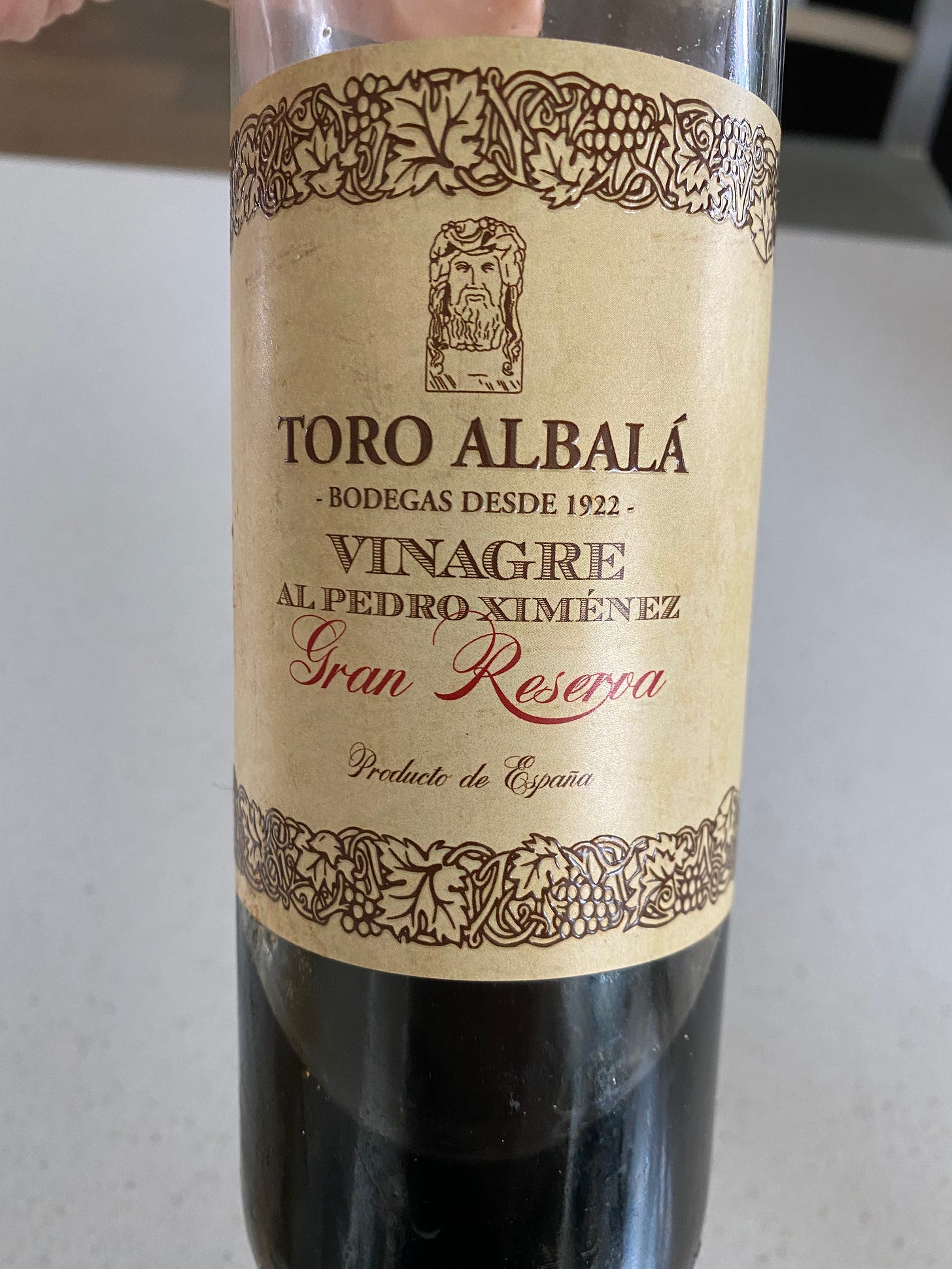Dressing Up, Dressing Down: Vinaigrette
Master a Basic Vinaigrette and There's No Limit to Your Salad Dressing Potential
Welcome to Issue #13. I seem to be returning to basics in recent issues (poaching eggs, making pie crust, mayonnaise)‚ and this week I’ve got another one for you: vinaigrette. The two most common questions asked by guests at my table are: How did I whip up something so quickly? And, How did I think of it? The answer to both is the same: I rely on the basics. I know “basic” has become slang for someone who tries too hard and misses the mark. (Admittedly, I may have just committed this sin by trying to explain something I barely understand.) But in food, the basics are your ticket. You should always have the ingredients you need for basic things, like a vinaigrette, in your cupboard. And then, once you master them, I mean, really understand what makes these simple, timeless recipes work, you open a world of quick, infinite deliciousness.
Every evening after dinner, Madame would make a vinaigrette in the bottom of a large plastic salad bowl before she added the lettuce. A spoonful of Dijon mustard, a pinch of salt, a splash of white wine vinegar. She beat it all with a fork as she drizzled in olive oil. In went floppy leaves of Bibb lettuce with a grind or two of black pepper. I was living with a family in the 8th arrondissement of Paris at the start of my junior year of college. Honestly, Madame wasn’t a very good cook. But she was very French and she made an excellent vinaigrette.
I love salad. Any kind really—from a simple Roman misticanza of wild leaves dressed with olive oil and vinegar to a complex Thai salad composed of shredded fried fish, vegetables, and herbs with a pungent dressing, and everything in between. Full of life and vitality, a good salad excites me. A bad salad—the kind you find wilting in clam-shell containers at off-brand airport food courts with iceberg lettuce, a ring of green pepper, a slice of red onion, and a packet of balsamic vinaigrette—depresses me. One of my favorite interviews about food I’ve ever given was talking to the queen of salad, herself, Emily Nunn, for her Department of Salad newsletter because it made me think of all of the sorts of salads I’ve made, ordered, and enjoyed during my life. My husband Nate makes fun of my love of salad.
When it comes to dressings, I generally stick to the basics. I rarely tire of olive oil and vinegar, provided both are of superior quality (see notes below for some recommendations). When I do, I make a basic vinaigrette. And if I want to get really fancy, I gussy up that vinaigrette with any number of mix-ins.
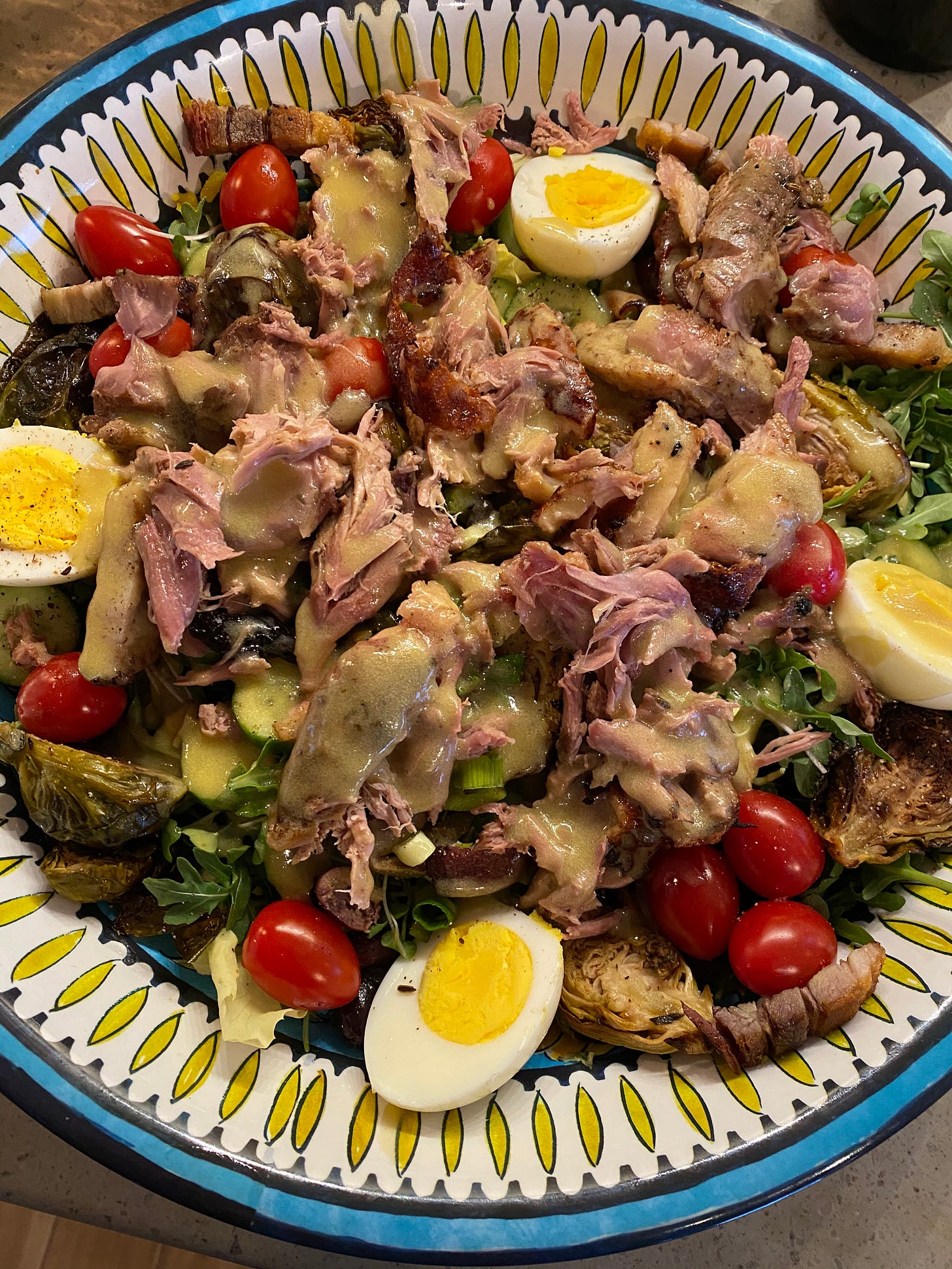
There have been periods when I’ve gotten more adventurous with dressings. I have a friend Clive, who is a masterful salad-dressing maker. After renting a few vacation homes with him and his wife Suzanne, he inspired me to branch out. Night after night Clive would make some delicious concoction for our salad—blue cheese, beet, roasted shallot. He often used the dregs of pickles or other preserves as inspiration. That was around the time I was writing my Kitchen Sense cookbook, and I watched and took notes as Clive worked. Despite replicating what I saw him do, what he confirmed he did, for some reason my dressings never seemed to have the same zing as Clive’s. I began to wonder if salad dressings just taste better when someone else makes them.
I returned to basic vinaigrette.
Years later, just a few months ago, in fact, when Ms Nunn started writing her newsletter, I upped my dressing game again. Her depictions were just too evocative to resist. Ranch, carrot miso, and green goddess entered my rotation. Emily’s recipes are great. But a whole batch of any one dressing was more than Nate and I could consume before getting a little tired of it.
And so I’ve retreated to the basics, again.
That’s the thing about certain basic recipes. You never tire of them. Come to think of it, my vinaigrette is not exactly basic because I add white miso for flavor and texture. The umami of miso boosts your salad’s yumminess and the physical qualities of miso help stabilize the emulsion, making the dressing creamier and more likely to hold any mix-ins in suspension without breaking.
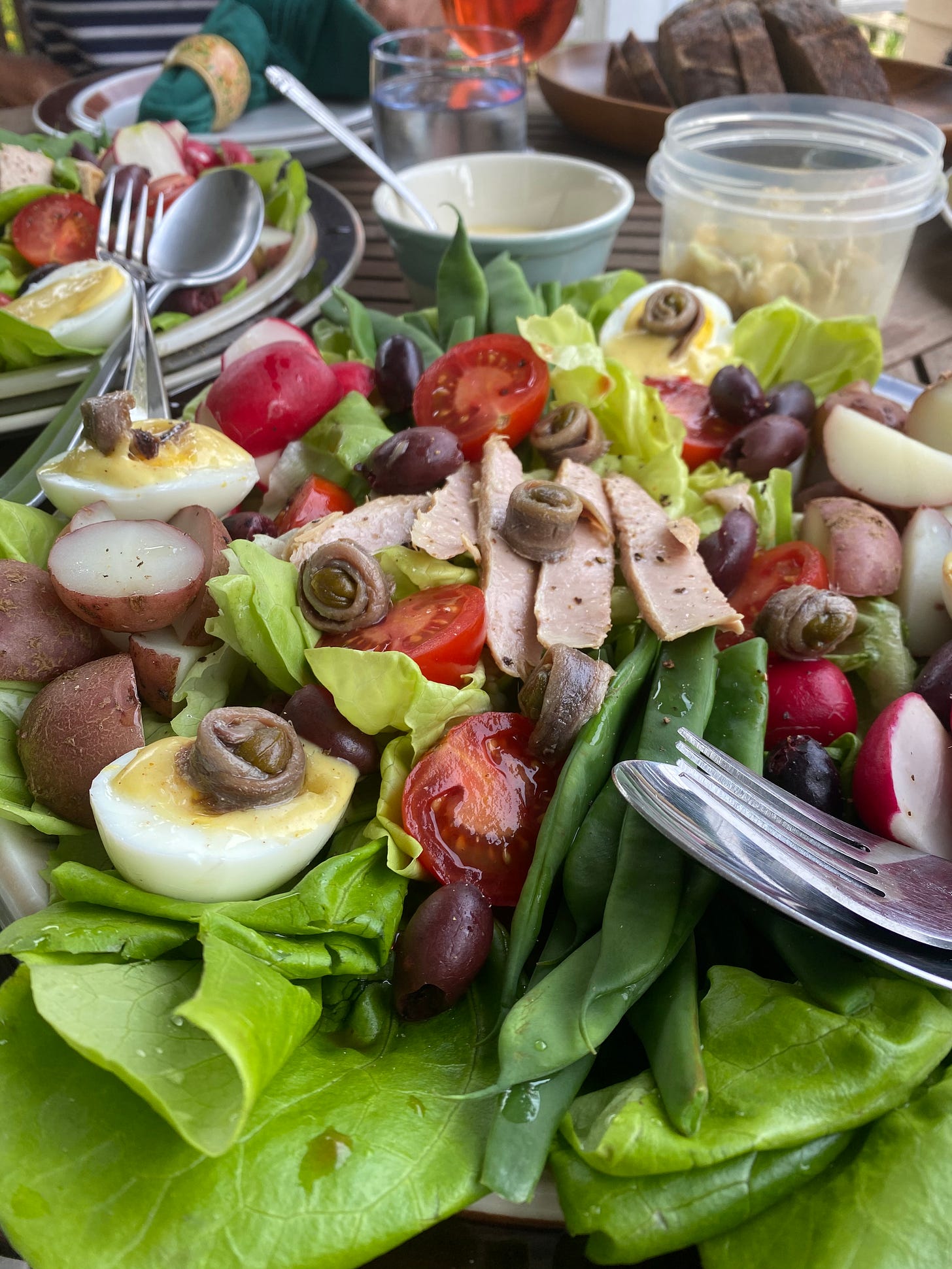
My vinaigrette is delicious as is, but you can use it as a base for an infinite number of variations. I find the proportion of about 1:4 for acid to fat the most pleasing to my taste, but experiment until you find yours. Sometimes I dress a salad with nothing but olive oil and salt (molto italiano), other times just a squirt lemon—depends on my mood. I never measure when I’m making a vinaigrette, but I did a few times so I could provide you with a recipe you can adjust and adapt. As you experiment, try to keep the acidity level in balance, so if you are adding a sour pickle juice, reduce the vinegar. If you add a spoonful of something sweet, a bitter marmalade, for example, increase it. When done, you can mix in a zillion different things to make a dressing that’s rich, creamy, chunky, spicy, sweet, or otherwise delicious. See notes following the recipe.
RECIPE: Basic Vinaigrette
Makes about 1 cup
1 teaspoon white miso
1 tablespoon Dijon mustard
3 to 4 tablespoons red or white wine vinegar
Salt
About ¾ cup extra-virgin olive oil
2 to 3 tablespoons hot water
Freshly ground black pepper
Combine the miso and mustard in a small bowl with the vinegar and a generous pinch of salt. Using a small whisk or a fork, beat together to blend. Continue beating while you slowly dribble in the olive oil, emulsifying the mixture as you go. The mixture will thicken as you add more oil. At a certain point, beat in a tablespoon or two of hot water to loosen the texture and adjust the flavor and continue beating in more oil until you have the amount of vinaigrette and the balance of acidity you like. Add a grind or two of black pepper and set aside at room temperature until ready to serve. The vinaigrette can be stored for several days at room temperature or in the fridge for a week or more. If storing chilled, bring back to room temperature and beat to re-emulsify before using.
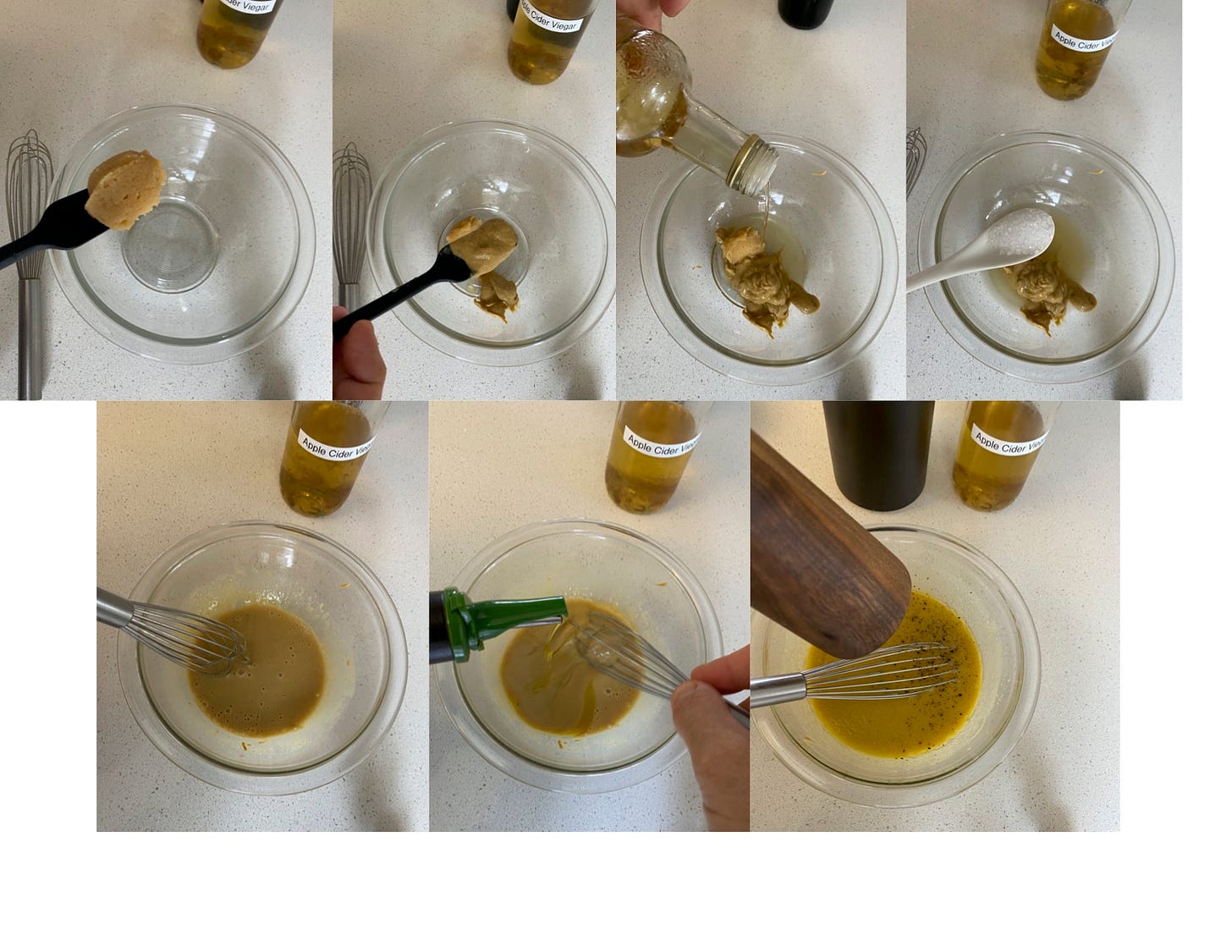
Notes about Ingredients and Variations
Miso or Other Flavorful Pastes
Of course, miso is not traditional in a French vinaigrette. But I’m on a miso kick lately, and as I said above, I find that a little bit in a dressing like this helps boost the flavor with umami and improves the stability of the emulsion. These day’s I am particularly loving Kyoto’s saikyo miso, a very delicate, white, almost-sweet miso, but any white miso will work as long as the texture is smooth. In place of miso, you can use a wide variety of flavorful, umami-rich pastes, such gochujang or another chile paste, green or black olive paste, anchovy paste, tomato paste, keep going. There’s a new paste on the market made from preserved lemons, that I love in dressings (see NY Shuk). I’ve been known to purée many different things into a paste, such as Indian mango or lime pickle, bitter marmalade, various chutneys, and add them to my dressings. Egg yolk falls into this “paste” category for me, and occasionally I’ll plop one into a vinaigrette to emulsify it like a mayonnaise. All of these pastes serve the same functions as the miso, boosting flavor and stabilizing the emulsion.
Mustard
Mustard is really just another flavorful paste, but for me it is essential. All Dijon mustards are not created equal and some are actually quite bitter (I avoid Grey Poupon). Most now also include preservatives, including Maille, which disappoints me. I’m always looking for brands of Dijon mustard from France that do not contain any preservatives. When I find one, I always buy several jars. Currently I’m using Clovis brand, which just contains mustard seeds, vinegar, and salt. Read your labels. You can vary the mustard you use for a vinaigrette. I’ve used grainy mustard, violet mustard, honey mustard, walnut mustard. A friend of ours in upstate NY makes a quince mustard that’s lovely in a vinaigrette.
Oil and Other Fats
For flavor and health reasons I use extra-virgin olive oil almost exclusively in my dressings. I usually have two qualities of EVOO on the go at anyone time, a general-use oil for things in which the flavor of the oil will be masked by other ingredients (vinaigrette included) and for frying, and a very fine olive oil to use simply on salad or in other pure, raw, drizzly ways. Our general house extra-virgin olive oil these days is Partanna from Sicily.
When I want to use a more neutral oil, I reach for grapeseed or avocado oil. But you can get creative with oils, too. Right now I have on hand toasted walnut oil, toasted pistachio oil, and toasted pumpkin seed oil, all of which are delicious in dressings. These specialty oils can be too intense (and too expensive) to replace all of the oil in a vinaigrette, but swapping out some of the oil makes a great impression. When using any of these unrefined nut or seed oils make sure they haven’t gone rancid, which they do pretty quickly. Rancid oil, which has a sort of cloying off taste that gets up into your brain, will ruin your salad, in my opinion. Always taste them first—even if you just bought them because you have no idea how long they have been hanging around the shop—and if there’s any question, throw it out (or return them). Come to think of it, extra-virgin olive oil also goes rancid fairly quickly if you don’t use it. Mine never stays around long enough, but if you’ve had yours a while, be sure to check. Taste early, taste often.
Don’t pass over and discard the oils that come with things like marinated artichokes, Spanish tuna, or Italian anchovies. These add tremendous flavor to a basic vinaigrette.
Besides oils, melted fats, such as bacon grease, chicken schmaltz, duck fat…oooh…and butter, slightly warmed to liquify, are quite delicious in dressings, too. When I make a salad with duck confit on it—which I do fairly regularly (see photo)—I always stir the fat that renders from reheating the duck into the dressing. Don’t substitute all of the oil for these fats; use just enough to enhance the dressing.
Heavy cream, sour cream, buttermilk or plain yogurt make a nice, rich addition to a dressing, changing the overall character from prickly to creamy. Because of their richness I generally think of them as falling into the oil category, and reduce the amount of oil I beat into the dressing to keep everything in balance. You can also beat in a dollop of mayonnaise to add non-diary richness of a similar sort.
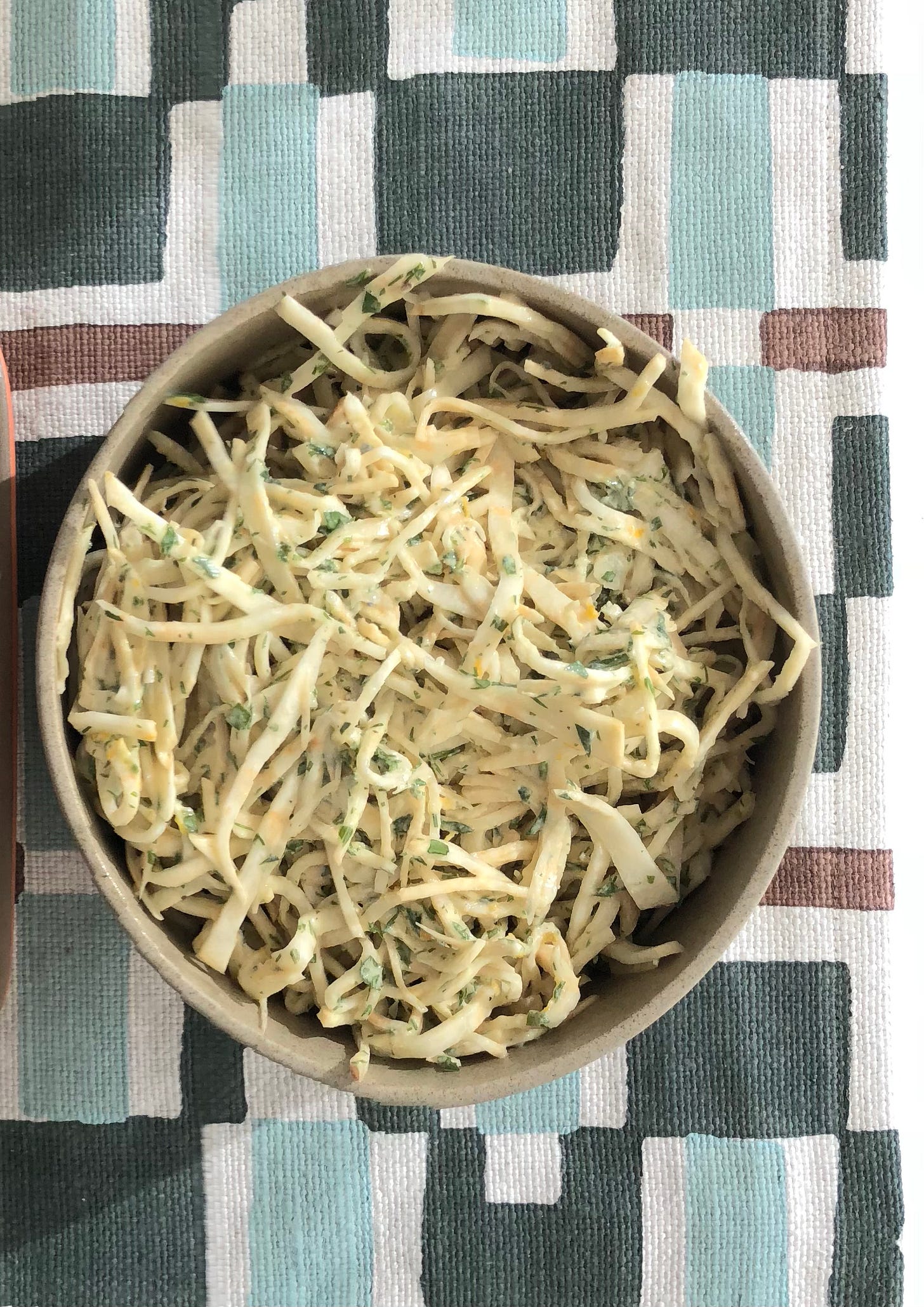
Vinegar and Other Acids
With regularity I use three types of vinegar in dressings: white wine vinegar, red wine vinegar, and apple cider vinegar. As with oil, the better the vinegar you buy, the better your dressing will be. Of course, any vinegar will work and I have bottles of Champagne, Sherry, and other vinegars on the go as I type. My current obsession is this Toro Albaná Vinegar Pedro Ximénez Gran Reserva It’s pricey, but every time I drizzle some, I lick my thumb and remark how delicious it is.
(ASIDE: Last night I was rummaging through the pantry, looking for car snacks as we were about to leave to drive upstate and I accidentally jostled a spare bottle of this vinegar, which fell, shattered, and exploded all over the pantry and hallway closet. Fun! Good thing we like the aroma of this vinegar, which, along with errant shards of glass, will no doubt greet us when we return. I was too upset to take a photo.)
Unlike special oils, special vinegars won’t go bad. Have a few in rotation. One vinegar not to use is in a dressing is the hyper expensive traditional balsamic vinegar of Modena, the one that comes in the regulation, squat 100 ml jar. Like the finest olive oil, this should be used as is, not mixed into anything that infringes on its unique, complex flavor. Avoid plain white vinegar, too, if you can. It has a sharp, bracing quality that I find too harsh on its own. I will, however, sometimes use a capful of white vinegar to bump up the acidity of a dressing if the balance is off.
For other acids, consider the entire category of citrus, all of which you can use, provided you adjust the acidity accordingly. For instance, Meyer lemons are fragrant, but their juice is too sweet to hold a dressing on its own. Pomelo juice has a pleasant, distinct flavor, and low acidity. Both need an acid boost to make a vinaigrette sing. And for sure think of using any remnants of pickle or preserve, pickled beets, olives, pickled onions, pickled peppers, anything that has a tang, and consider using that up in a dressing of some kind.
Salt
It’s best to add the salt at the beginning when you make a dressing so that it has time to dissolve in the liquid. Mustard, miso, and many of your mix-ins are salty, too, I realize, but a good salad usually requires a little more. In fact, when I go to toss a salad (see below), I always add another pinch and some more black pepper. I don’t like things to be so salty that you taste the salt, but I also can’t stand when things are under salted. I’ll leave it to you to find the right balance for your taste. Keep in mind it is much, much easier to add salt than to take it away. And also keep in mind that flavored salts, with herbs and other spices, can be nice, subtle additions to dressings.
Water and Other Liquids
The water in my vinaigrette helps dilute the acidity of the vinegar and thins the emulsion to a consistency that’s best for coating the salad, without throwing the balance of flavors out of whack. Hot water keeps the olive oil or other fat from coagulating the way cold water would and further stabilizes the emulsion. To add additional flavor complexity, can use other liquids, too, such as chicken stock or vegetable stock, or even chick pea or other white bean cooking water, or the juices of canned tuna, roasted beets, or other cooked vegetables.
Mix-Ins
I presume the original vinaigrette mix-in was minced shallot, and it’s still a winner. Chopped herbs, such as tarragon and marjorm, likely followed right behind. But so many things are good in dressings: crumbled feta or blue cheese, chopped olives, toasted nuts, dried fruit, seeds, spice mixes (such as zaatar and dukkah or garam masala or ras el hanout).
Don’t stop at things in your cupboard. Try sautéing red onion in bacon fat or duck fat, and adding that to your vinaigrette. Toast walnuts in butter and dump the pan in. There’s really no limit to what you can stir into a vinaigrette.
A Note about Tossing
There is a real art to tossing a salad with dressing, getting the amount just right so there isn’t too much that the leaves are drowning or too little that it’s a tease. Plus, there is the challenge of tossing a salad without half of it ending up on the counter or the floor. There are stories told of garde-mangers in Michelin three-star restaurants dipping individual leaves of lettuce in vinaigrette and then hanging them on a line to dry before composing the salad in order to get it just right. If I’m going to toss a salad with its dressing, I prefer to do it in a large mixing bowl just before I serve it. I add another pinch of salt, some fresh pepper, and just enough of the vinaigrette to coat. Using tongs, I toss everything well and then transfer it to a salad bowl to serve, making sure any special components of the salad are visible and attractively arranged. I offer additional dressing on the side for those who want it.
More often for the two of us I don’t toss the salad with the dressing at all. I serve the dressing on the side. A tossed green salad doesn’t keep, the acid and salt of the dressing destroy the leaves as they sit. Keeping them separate keeps both salad and dressing ready for another meal. And, as you know, my next meal is always on my mind.



